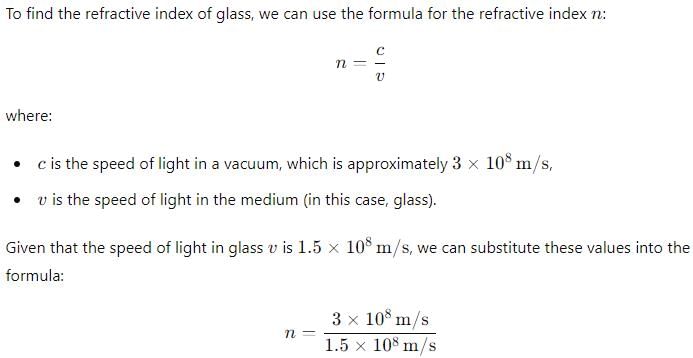UPSC Exam > UPSC Tests > Test: Refraction through Glass - UPSC MCQ
Test: Refraction through Glass - UPSC MCQ
Test Description
10 Questions MCQ Test - Test: Refraction through Glass
Test: Refraction through Glass for UPSC 2025 is part of UPSC preparation. The Test: Refraction through Glass questions and answers have been prepared
according to the UPSC exam syllabus.The Test: Refraction through Glass MCQs are made for UPSC 2025 Exam.
Find important definitions, questions, notes, meanings, examples, exercises, MCQs and online tests for Test: Refraction through Glass below.
Solutions of Test: Refraction through Glass questions in English are available as part of our course for UPSC & Test: Refraction through Glass solutions in
Hindi for UPSC course.
Download more important topics, notes, lectures and mock test series for UPSC Exam by signing up for free. Attempt Test: Refraction through Glass | 10 questions in 10 minutes | Mock test for UPSC preparation | Free important questions MCQ to study for UPSC Exam | Download free PDF with solutions
Detailed Solution for Test: Refraction through Glass - Question 1
Test: Refraction through Glass - Question 2
What will happen when a ray enters from glass to air medium ?
Detailed Solution for Test: Refraction through Glass - Question 2
Test: Refraction through Glass - Question 3
The speed of light in glass is 1.5 x 108m/s. Then refractive index of glass is
Detailed Solution for Test: Refraction through Glass - Question 3
Test: Refraction through Glass - Question 4
Light travels faster in substance X as compared to substance Y, then refractive index is greater for
Detailed Solution for Test: Refraction through Glass - Question 4
Test: Refraction through Glass - Question 5
During refraction through a rectangular glass slab, what can be said about the angle of incidence and the angle of refraction at the refracting surfaces?
Detailed Solution for Test: Refraction through Glass - Question 5
Test: Refraction through Glass - Question 6
Light enters from air to glass having a refractive index of 1.50. What is the speed of light in the glass? The speed of light in a vacuum is 3×108 m/s.
Detailed Solution for Test: Refraction through Glass - Question 6
Test: Refraction through Glass - Question 7
A light ray is incident at an angle of 30 degrees on a medium with a refractive index of 1.5. What is the angle of refraction if the light is moving from air to the medium?
Detailed Solution for Test: Refraction through Glass - Question 7
Detailed Solution for Test: Refraction through Glass - Question 8
Test: Refraction through Glass - Question 9
The refractive index of diamond is 2.42. What is the meaning of this statement?
Detailed Solution for Test: Refraction through Glass - Question 9
Test: Refraction through Glass - Question 10
Which of the following statements about the refractive index of water is true?
Detailed Solution for Test: Refraction through Glass - Question 10
Information about Test: Refraction through Glass Page
In this test you can find the Exam questions for Test: Refraction through Glass solved & explained in the simplest way possible.
Besides giving Questions and answers for Test: Refraction through Glass, EduRev gives you an ample number of Online tests for practice
Download as PDF

















